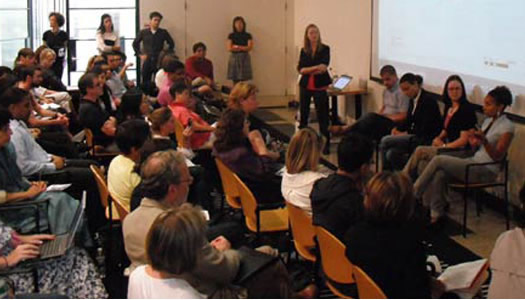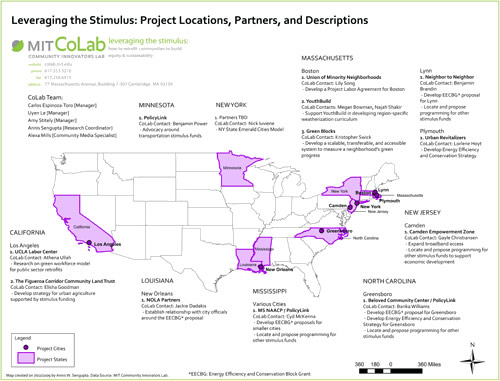Archive
Leveraging the Stimulus

In early March 2009, a group of 20+ MIT students, faculty, and CoLab staff worked together to deeply understand how the disbursement of the American Recovery Reinvestment Act (ARRA) was taking place and how the stimulus funds could be leveraged to achieve sustainable, empowered, prosperous, and equitable communities. This group, working within the Leveraging the Stimulus project at the CoLab and the CityScope class at DUSP, developed a report and framework that defines and advocates for "deep retrofits," providing a template for how such retrofits can contribute to broad environmental, economic, and social goals. This report is called "Leveraging the Stimulus: How to Retrofit Communities to Build Equity and Sustainability".
Leveraging The Stimulus Milestones & Resources
The "Innovation and Equity Can Transform America" policy series provided eighteen briefs, written by leading scholars and policy makers, to the Obama Presidential Transition Team that focus on the role of equity in today's critical policy challenges. The goal of these papers is to open up policy conversations in new directions that we believe go to the heart of our problems and aspirations and that move beyond business as usual. The papers are grouped into four basic categories: 1) growing an equitable economy; 2) transforming the urban environment; 3) sustaining people and families; and 4) re-imagining community.
Stimulus Disbursement Project
CoLab assembled a team of staff and students to take on the task of mapping the ARRA disbursement funds from the federal to the community level. This team prepared drafts of diagrams and matrices such as mapping the disbursement. Building upon these initial drafts, CoLab developed a comprehensive Plan Model that promotes equitable community development through the retrofitting of buildings in low-income communities. The selected final products below are the result of the collaborative effort among DUSP students, faculty and other collaborators.
May 11, 2009 Community Leaders Meeting
On May 11, 2009, a group of community leaders from across the nation gathered in New York to discuss what they are doing locally to improve their communities with the stimulus money. MIT graduate student researchers Uyen Le and Sarah Nusser presented an extensive flow diagram and spreadsheet breaking down all green-related stimulus package funds. They represented a team of 12 contributing students. Additionally, Nelson Johnson from Beloved Community Center in Greensboro NC, Burt Lauderdale from Kentuckians for the Commonwealth, and Derrick Johnson from Mississippi NAACP presented what they are doing locally, on the ground, in their own communities to take advantage of stimulus money.

Leveraging The Stimulus Summer 2009 Program
During the summer of 2009, about a dozen student-practitioners were deployed to cities across the country to work with community-based partner organizations. Using the plan model as a guide, student-practitioners were tasked with helping their partners work collaboratively in coalitions to help cities to leverage stimulus dollars for transformational change at both neighborhood and city-wide scales.
Once in the field, student-practitioners were faced with the complex technical and political challenges associated with mobilizing change in our nation's urban centers. After reassessing their partners' strategic positions and commitment to engaging in the stimulus process, six projects emerged that were directly connected to the ARRA legislation. Of these six projects, four engaged the question of how to form community-based coalitions and new kinds of partnerships in order for community organizers and planners to move to a proactive model of civic engagement for sustainable economic development.
Contact:
Dayna Cunningham
dayna@mit.edu
